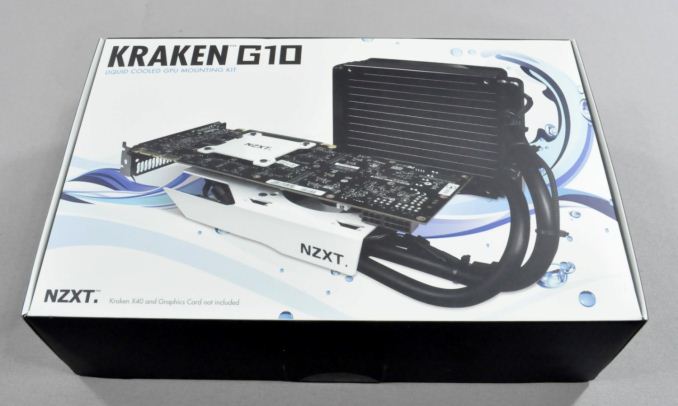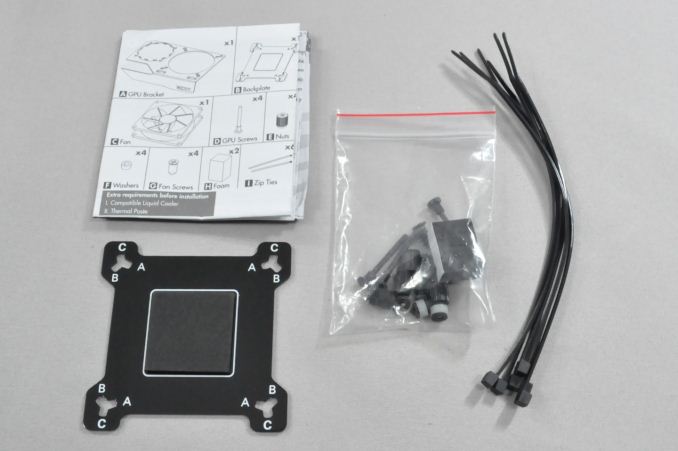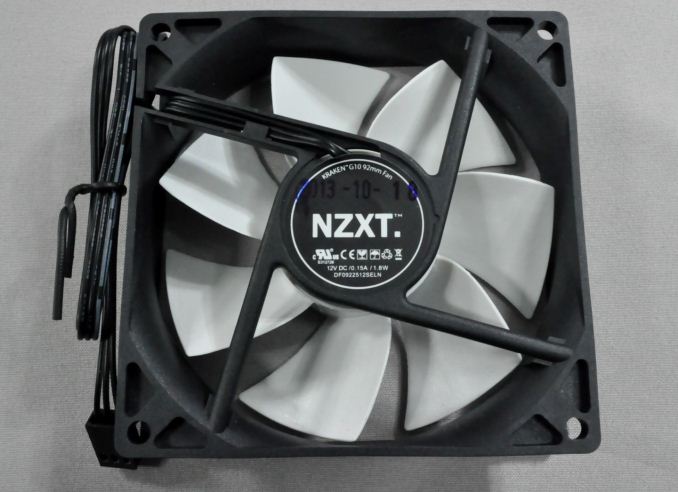NZXT Kraken G10 Review: Liquid Cooling for Your GPU
by E. Fylladitakis on March 11, 2014 1:15 AM EST- Posted in
- Cases/Cooling/PSUs
- NZXT
- Water Cooling
- Kraken
- G10

Introduction
Liquid-cooling is nothing new in the world of computers; enthusiasts first started creating custom water cooling setups back in the 80486 era, and even prior to that some mainframes used liquid-cooling. Due to their cost and complexity however, such cooling solutions often do not appeal to a large portion of users. With the advent of of closed loop, ready-to-run liquid-cooling kits from Asetek and CoolIT a few years back, however, liquid-cooling is now significantly less costly and complex. Today, the cooling solutions of both these two OEMs are being marketed by several brands and are becoming increasingly popular among all classes of users.
Despite the low cost and ease of installation however, these closed loop systems entirely lack the one thing that a custom liquid-cooling solution has: versatility. All of the closed loop liquid-cooling kits currently available in the market are designed be installed on a single CPU, without the possibility of any expansion, whereas custom setups could potentially cool all of the critical components in a system. Until recently, those who purchased any closed loop liquid-cooling kit were limited to cooling their CPU only, leaving their high-end graphics cards running on air. NZXT came up with a very simple and effective solution to this problem: a metallic bracket called the Kraken G10 that allows the installation of any Asetek-based liquid-cooling kit on most modern graphics cards. The compatibility list, as provided by NZXT, is as follows:
| GPU Compatibility |
Nvidia: GTX 780 Ti, 780, 770, 760, Titan, 680, 670, 660Ti, 660, 580, 570, 560Ti, 560, 560SE AMD: R9 290X, 290, 280X*, 280*, 270X, 270 HD7970*, 7950*, 7870, 7850, 6970, 6950, 6870, 6850, 6790, 6770, 5870, 5850, 5830 The compatibility list is based on AMD's Radeon and NVIDIA's GeForce reference board layouts, screw spacing, and die height only. Please check the height restriction before purchase. * Some variations in AMD die height may require the use of a shim. |
| Liquid-cooling kit compatibility |
NZXT: Kraken X60, Kraken X40 Corsair: H110, H90, H75, H55 , H50 Antec: KUHLER H2O 920V4, KUHLER H2O 620V4, KUHLER H2O 920, KUHLER H2O 620 Thermaltake: Water 3.0 Extreme, Water 3.0 Pro, Water 3.0 Performer, Water 2.0 Extreme, Water 2.0 Pro, Water 2.0 Performer Zalman: LQ-320, LQ-315, LQ-310 |
Packaging and bundled items
NZXT ships the Kraken G10 in a well-designed cardboard box, displaying their Kraken X40 liquid-cooler installed on a graphics card with the help of the bracket. Inside the box we find a leaflet with installation instructions, the hardware required for the installation of the bracket, and a few cable ties.
NZXT also supplies a 92mm fan, which can be installed on the Kraken G10 in order to cool the VRM and RAM chips of the graphics card. Such parts are inherently cooled by the stock cooler of the card, but as that will be removed and the liquid block only cools GPU core, the fan is a useful addition. The white-bladed fan comes from Martech and is a sleeve bearing, 2000RPM model.













61 Comments
View All Comments
Nirvanaosc - Tuesday, March 11, 2014 - link
... the fan speed / temperature curve. Just perfect.I have it controlling 8 fans + 2 pumps (6 GPU and + pump and 2 CPU + pump) in 3 PWM channels.
Streetwind - Tuesday, March 11, 2014 - link
You claim that there is currently no competing product, but what about Arctic Cooling's Accelero Hybrid cooler? True, it's not just a bracket, but rather a complete solution. But still, it does the same thing, cooling the GPU with a closed water loop and the other onboard components with a small dedicated fan. It's been on the market since summer 2012.Overall though, I like the flexibility the mounting bracket offers. Users can pick and choose the liquid loop they want or need for their card and/or goals, which is important considering how much the various solutions differ in terms of price, noise and performance. And in general, I think that closed liquid loops are horribly overpriced and overspecced for CPU cooling without showing any real advantage over air solutions, whereas on a GPU their high potential can actually be utilized (as the temperature results in this test show).
Now if we could just get an Asetek pump unit that was truly quiet in idle mode, even I might start to show genuine interest... ;)
SquattingDog - Tuesday, March 11, 2014 - link
Any chance of testing additional cards, such as the 7970/280X as these require "shims" which do not appear to be included in the kit?! Also other higher power cards such as 780GTX, 290 and 290X would be great to see how it performs with them.Folterknecht - Tuesday, March 11, 2014 - link
http://www.tomshardware.de/r9-290-umbau-wasserkuhl...BlakKW - Tuesday, March 11, 2014 - link
In terms of what I might spend money on in the near-future, this is the most interesting mini-review + comments that I've seen on AT in long time... tyGigaplex - Tuesday, March 11, 2014 - link
"While saying, "80 °C to 45 °C – oh, that's 44% lower temperatures" is technically correct"No, it's not even technically correct. When comparing temperatures like this, you need to either measure the delta from ambient (sensible) or measure from absolute zero (less sensible). 45 °C is not 56% of 80 °C, convert to Fahrenheit and try to make the same claim.
JarredWalton - Tuesday, March 11, 2014 - link
Of course it's "technically correct", meaning that the temperature dropped 45C. But as we go on to explain, that's not really looking the right aspect. It's like arguing that saying "the sun is shining" isn't "technically correct" because if we get into the nitty gritty details, "shining" isn't really the right word. Good grief! There are all sorts of reasons to not simply compare temperatures, which is why E. uses the more useful C/W and explains why it's more useful.JarredWalton - Tuesday, March 11, 2014 - link
Maybe we should switch to Kelvin though? LOLRick83 - Wednesday, March 12, 2014 - link
It's not technically correct, and NZXT should be called out for spouting such ridiculous marketing rubbish.It's just as incorrect as 4 inches being twice as long as 3 inches, because 0 inch celsius is equal to 2 inches. You cannot use linear scaling with fixed offset units. Doing so to get impressive marketing numbers is misleading, and should be punished. I for one will avoid NZXT, thanks to this ludicrous display of marketing mistakes, where the engineers weren't asked to proofread wild marketing claims.
E.Fyll - Tuesday, March 11, 2014 - link
You are correct. Unfortunately my original text was phrased in a rather, um, "insensitive" manner, and thus an editor rightfully felt that he had to edit it. It is my fault, as I need to be more careful of how I phrase certain things.True enough, it is not technically correct. It just is not correct at all, in any way possible. :)